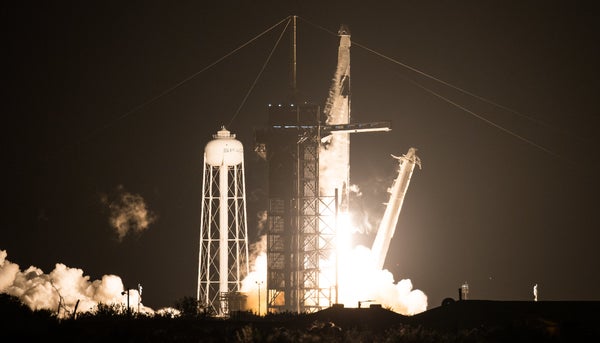The future that NASA dared to dream of for a decade has finally become reality.
Crew-1, SpaceX’s first operational mission to the International Station Station (ISS) for NASA, arrived at the orbiting lab late Monday night (Nov. 16), 27 hours after launching from Kennedy Space Center in Florida atop a Falcon 9 rocket.
About two hours after the Crew Dragon capsule “Resilience” docked with the station, NASA astronauts Victor Glover, Mike Hopkins and Shannon Walker and Japan’s Soichi Noguchi floated from the private craft into the ISS, beginning their six-month stay on the orbiting lab.
On supporting science journalism
If you're enjoying this article, consider supporting our award-winning journalism by subscribing. By purchasing a subscription you are helping to ensure the future of impactful stories about the discoveries and ideas shaping our world today.
That moment meant a lot to NASA, whose Commercial Crew Program began nurturing the development of private astronaut taxis way back in 2010. The goal was to fill the crew-carrying shoes of the agency’s space shuttle fleet, which was grounded in 2011, leaving Russian Soyuz spacecraft as the only ride to and from orbit available to astronauts.
In 2014, the Commercial Crew Program inked multibillion-dollar contracts with SpaceX and Boeing to finish work on their vehicles and fly at least six crewed missions to and from the station apiece. Crew-1 is the first of those contracted flights to lift off, and its crewmembers have now made it safely onto the orbiting lab.
“This mission was a dream,” NASA human spaceflight chief Kathy Lueders said during a news conference early Tuesday morning (Nov. 17). "It was a dream of us to be able to one day … have crew transportation services to the International Space Station. And today that dream became a reality.”
“It’s the start of a new era,” Lueders added.
That era will include crewed missions by Boeing, but the aerospace giant’s CST-100 Starliner capsule isn’t ready to carry astronauts just yet. Starliner must first refly an uncrewed test flight to the station, after failing to meet up with the ISS during a December 2019 attempt. That second try is scheduled to launch early next year.
SpaceX now has two crewed flights to the ISS under its belt. The first, the Demo-2 test mission, carried NASA astronauts Bob Behnken and Doug Hurley to the station for a two-month stay this past summer. Demo-2’s success paved the way for Crew-1 and other operational flights.
“Huge shoutouts to the NASA and SpaceX teams—excellent job; many hard years of work,” Ven Feng, deputy manager of NASA’s Commercial Crew Program, said during Tuesday morning’s news conference. “And we’re looking forward to making this a very successful first operational mission, and many more to follow.”
The Crew-1 astronauts joined three other spaceflyers already aboard the ISS—NASA astronaut Kate Rubins and cosmonauts Sergey Kud-Sverchkov and Sergey Ryzhikov, the latter of whom commands the station’s current Expedition 64 mission.
Copyright 2020 Space.com, a Future company. All rights reserved. This material may not be published, broadcast, rewritten or redistributed.
